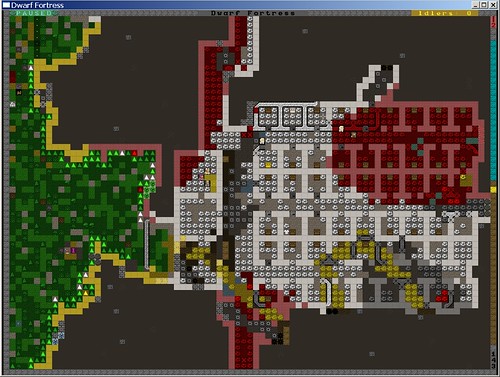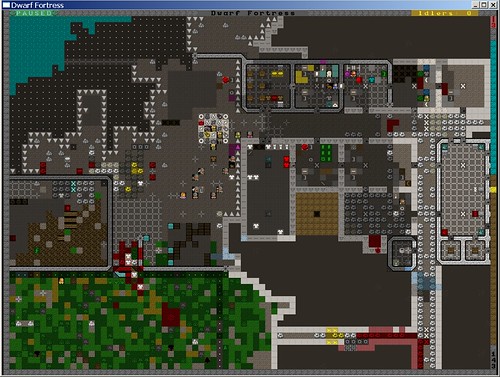I started the game a couple of months ago, but it kept crashing (a problem I'd never had with DF before). So I put it aside for awhile. With the latest version, 0.31.12, that's been fixed. And a couple of rainy days gave me all the excuse I needed to pick it up again. It's been great fun!
If you're not familiar with Dwarf Fortress, it's really kind of hard to describe the appeal of the game. Frankly, the interface stinks, the learning curve is a killer, and the unmodded game uses ASCII graphics! Even with the May Green graphics bundle I'm using, it's an understatement to describe them as "minimal." (I've posted some screenshots below the fold.)
But the gameplay is wonderful! My description won't do it justice, but basically you take a party of dwarves into the wilderness to carve out a home. It's a fortress, because it's a dangerous world. But it's also a trading post, a farmstead, and a center for all sorts of crafts. If you're successful, you'll attract immigrants until you have a thriving community.
And every one of your dwarves is an individual, with an individual appearance, personality, likes and dislikes, mannerisms, and skills (which improve with use). You can give them a task list and assign them responsibilities, but they themselves choose when to do what. They eat when hungry, drink when thirsty, rest when tired, sleep when sleepy, and even socialize when they need a party. They make friends (and grieve when those friends are killed), adopt pets, get married, and raise children.
For the most part, the game is perfectly logical. If you can think of a logical way to do something, you can probably do it. It's wide open. This game doesn't tell you what to do, it lets you make the decisions. And although there are many, many ways to lose, there's no way to win. "Winning" just means that your fortress is still going strong. Dwarves die, they're buried in plain coffins or elaborate tombs, and life goes on. Until it doesn't.
My latest fortress, Toraliden ("Lawpaddles"), has been under construction for just over two game-years now, which isn't long at all. Still, we're up to 60 dwarves (including three babies and two children), having lost two in violent incidents. I didn't originally intend to document our experiences, so I don't have any screenshots of the beginning. But if you're interested, I'll describe what's happened so far below the fold.
In the spring of 1051, seven dwarves led by Aban Etasgeshud, a skilled cook (well, we are talking about dwarves, after all) set out to found the new settlement of Toraliden, eager for fame and fortune. We chose a spot where a creek cut through the mountains, creating a natural defensive barrier to our west, with good soil for surface crops, plenty of trees, sand (for an eventual glass industry), and plenty of minerals, including iron ore and lots of chalk (for flux). And we confidently expect magma if we go deep enough underground.
We were a bit surprised to find the creek still frozen when we arrived, though it soon thawed. Dwarves much prefer to drink booze, but a source of water is still essential. So one obvious priority was to dig an underground cistern connected to the creek, and then build some wells, before the next winter.
Another priority was defense. Right away, we dug a moat and built a drawbridge in order to cut off one section of the lower mountain. A few walls and some earth-moving further secured the area. It wouldn't keep out flying creatures, but with the bridge raised, we'd be safe from most attacks. Of course, we'd also be isolated, and cut off from our source of timber, so we couldn't keep the bridge raised all the time.
But we did have a small area suitable for above-ground crops, like strawberries, within the enclosure. (Later, for even better security, we walled up the farm entirely, so the only entrance is now from below ground.) With inexperienced miners at first, we also set up our craftsmen in workshops on the surface. Our people weren't happy about sleeping on the ground - and getting rained on - but our enthusiasm was high enough to overlook some minor discomfort.
We had a calm spring and summer, but struggled to get food put away for the winter, especially since our first immigrants arrived and more than doubled our numbers. So we gratefully welcomed our first caravan of dwarven traders that fall. [Heh, heh. As it turned out, we were too grateful. It had been a long time since I'd played this game, so I mistakenly selected "o" (for "offer") instead of "t" (for "trade") and gave away everything I was attempting to trade, including some steel armor we could hardly afford to lose.]
Well, after that, the prospect of winter looked bleak indeed. But we got by. We got our cistern dug just before the creek froze up, and, despite the cold, we were able to plant and gather surface crops all winter long. Spring was welcome, when it finally arrived, but our spirits were still high. And we successfully traded with the elves in late spring.
So far, things had been very peaceful. We'd seen no dangerous animals at all (and still haven't), and although we knew there were goblins in the area, we hadn't seen any sign of them. We set a few traps at the entrance anyway - and a few more when two goblin thieves showed up. We also tied a kitten to a rope, some distance from our drawbridge, as an early-warning detector.
Eventually, a goblin warparty ambushed the kitty, alerting us to their presence and letting us get all our civilians safely inside and underground. Our military was still quite weak, still unprepared for a real battle, but we thought we had enough traps to take care of a handful of goblins. So we left the drawbridge down. Sure enough, the traps did a great job, killing or capturing every goblin. So we released the alert...
... and Ast Obokdeler, one of our original seven dwarves and a cat lover, went rushing out to bring the poor kitten's body back, stumbling into the second ambush party. He didn't last much longer than the kitten had, and although his sacrifice gave us some time to reinstate the alert, it wasn't much notice. The goblins were already close to the fortress entrance, and our traps had been severely depleted.
But we were lucky. Only three goblins made it past the traps, and all three were badly injured by them. Our inexperienced military eagerly rushed out to mop up, and they succeeded without taking the slightest damage themselves. Well, when your enemy is unconscious, lying on the ground bleeding profusely, I don't suppose the fight is ever likely to be too difficult. But it was still a morale boost.
Of course, Ast's lover, Likot, and his many friends (he was a very popular guy) grieved for his loss, but we gave him a good burial in a decent coffin, and life goes on. [Heh, heh. I just noticed that Ast's personality has changed since he's been dead. Now, "He doesn't really care about anything anymore." Funny, huh?]
When the dwarven caravan returned that fall, we were in much better shape [and I didn't mess up my commands this time], although the caravan didn't bring us much. (Perhaps they were expecting to get everything for free again.)
We've been trying to move everyone underground, out of the rain, and we've actually built a very nice dining hall in which to eat those truly wonderful meals our leader keeps preparing. Between that and the good booze, our dwarves are pretty happy. But they've become a little annoyed at still sleeping in a dormitory, after a full two years, so we're currently working hard on individual bedrooms.
Recently, we've had both good news and bad. The good news is that Toraliden was named a barony - and Aban, our leader, as the baroness. (Now, of course, she wants a fancy bedroom, office, and personal dining room, and she wants them now. Funny how a little power went to her head, isn't it? Well, at least she's still willing to cook.)
But we also lost another dwarf. For some unknown reason, Meng Edankogan, a recent army recruit, became very moody (not unusual in these circumstances) and couldn't seem to find what he wanted. He kept muttering about "square blocks," but our mason made stone blocks until they were coming out our ears, without any positive result. Eventually, Meng went completely insane and started beating on the nearest target, his two pet war dogs.
I guess that was lucky, because even unarmed, he nearly killed the dogs (in fact, one had to be put down afterward, and we're still not sure about the other one). I'm certain he would have attacked our dwarves, if he'd had half a chance. But while he was busy with the dogs, Unib Dorenothlest, our military commander, rushed up with an axe and chopped Meng's legs off. He bled to death very quickly after that.
We gave him a good burial. After all, insanity isn't something he could control. It just happens sometimes. Meng was a recent immigrant, so he hadn't yet made any friends. As it turns out, that was probably a good thing, although his death still puts a damper on spirits around here.
 |
| Bedrooms, under construction. Note the noble residence on the west side, also under construction. Should be a nice view from there, once we get the windows in. |
As I said, we're busy right now building individual bedrooms. Unfortunately, each of those requires a wooden bed, and wood is rather scarce. Well, partly that's because we have an agreement with the elves not to cut too many trees. (What's with elves and trees, anyway? They get furious if you even try to trade them something made of wood.) But it's also because, with goblins around, it's dangerous to send a woodcutter too far for lumber.
Luckily, we have lots of stone. And we're using some of it to build a trapped passageway, climbing high in the sky, that will lure in a whole goblin warparty and drop them ten stories onto the cold, hard ground (or onto spear points, if that really turns out to be necessary). Of course, we still have no defenses against flying creatures. And as we delve further and further underground, we're likely to disturb creatures far more dangerous than mere goblins. But first things first.
Assuming we survive, I'll try to post more about Toraliden later.


No comments:
Post a Comment